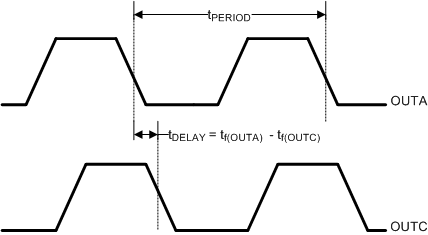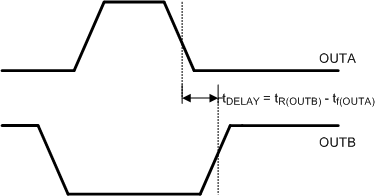SLUS157Q December 1999 – October 2019 UCC1895 , UCC2895 , UCC3895
PRODUCTION DATA.
- 1 Features
- 2 Applications
- 3 Description
- 4 Revision History
- 5 Pin Configuration and Functions
- 6 Specifications
-
7 Detailed Description
- 7.1 Overview
- 7.2 Functional Block Diagrams
- 7.3
Feature Description
- 7.3.1 ADS (Adaptive Delay Set)
- 7.3.2 CS (Current Sense)
- 7.3.3 CT (Oscillator Timing Capacitor)
- 7.3.4 DELAB and DELCD (Delay Programming Between Complementary Outputs)
- 7.3.5 EAOUT, EAP, and EAN (Error Amplifier)
- 7.3.6 OUTA, OUTB, OUTC, and OUTD (Output MOSFET Drivers)
- 7.3.7 PGND (Power Ground)
- 7.3.8 RAMP (Inverting Input of the PWM Comparator)
- 7.3.9 REF (Voltage Reference)
- 7.3.10 RT (Oscillator Timing Resistor)
- 7.3.11 GND (Analog Ground)
- 7.3.12 SS/DISB (Soft Start/Disable)
- 7.3.13 SYNC (Oscillator Synchronization)
- 7.3.14 VDD (Chip Supply)
- 7.4 Device Functional Modes
- 7.5 Programming
-
8 Application and Implementation
- 8.1 Application Information
- 8.2
Typical Application
- 8.2.1 Design Requirements
- 8.2.2
Detailed Design Procedure
- 8.2.2.1 Power Loss Budget
- 8.2.2.2 Preliminary Transformer Calculations (T1)
- 8.2.2.3 QA, QB, QC, QD FET Selection
- 8.2.2.4 Selecting LS
- 8.2.2.5 Selecting Diodes DB and DC
- 8.2.2.6 Output Inductor Selection (LOUT)
- 8.2.2.7 Output Capacitance (COUT)
- 8.2.2.8 Select Rectifier Diodes
- 8.2.2.9 Input Capacitance (CIN)
- 8.2.2.10 Current Sense Network (CT, RCS, RR, DA)
- 8.2.3 Application Curves
- 9 Power Supply Recommendations
- 10Layout
- 11Device and Documentation Support
- 12Mechanical, Packaging, and Orderable Information
Package Options
Mechanical Data (Package|Pins)
Thermal pad, mechanical data (Package|Pins)
- PW|20
Orderable Information
6.5 Electrical Characteristics
VDD = 12 V, RT = 82 kΩ, CT = 220 pF, RDELAB = 10 kΩ, RDELCD = 10 kΩ, CREF = 0.1 μF, CVDD = 0.1 μF and no load on the outputs, TA = TJ. TA = 0°C to 70°C for UCC3895x, TA = –40°C to 85°C for UCC2895x and TA = –55°C to 125°C for the UCC1895x (unless otherwise noted)| PARAMETER | TEST CONDITIONS | MIN | TYP | MAX | UNIT | ||
|---|---|---|---|---|---|---|---|
| UVLO (UNDERVOLTAGE LOCKOUT) | |||||||
| UVLO(on) | Start-up voltage threshold | 10.2 | 11 | 11.8 | V | ||
| UVLO(off) | Minimum operating voltage after start-up | 8.2 | 9 | 9.8 | V | ||
| UVLO(hys) | Hysteresis | 1 | 2 | 3 | V | ||
| SUPPLY | |||||||
| ISTART | Start-up current | VDD = 8 V | 150 | 250 | µA | ||
| IDD | Operating current | 5 | 6 | mA | |||
| VDD_CLAMP | VDD clamp voltage | IDD = 10 mA | 16.5 | 17.5 | 18.5 | V | |
| VOLTAGE REFERENCE | |||||||
| VREF | Output voltage | TJ = 25°C | 4.94 | 5 | 5.06 | V | |
| 10 V < VDD < VDD_CLAMP,
0 mA < IREF < 5 mA, temperature |
4.85 | 5 | 5.15 | ||||
| ISC | Short circuit current | REF = 0 V, TJ = 25°C | 10 | 20 | mA | ||
| ERROR AMPLIFIER | |||||||
| Common-mode input voltage range | –0.1 | 3.6 | V | ||||
| VIO | Offset voltage | –7 | 7 | mV | |||
| IBIAS | Input bias current (EAP, EAN) | –1 | 1 | µA | |||
| EAOUT_VOH | High-level output voltage | EAP – EAN = 500 mV, IEAOUT = –0.5 mA | 4 | 4.5 | 5 | V | |
| EAOUT_VOL | Low-level output voltage | EAP – EAN = –500 mV, IEAOUT = 0.5 mA | 0 | 0.2 | 0.4 | V | |
| ISOURCE | Error amplifier output source current | EAP – EAN = 500 mV, EAOUT = 2.5 V | 1 | 1.5 | mA | ||
| ISINK | Error amplifier output sink current | EAP – EAN = –500 mV, EAOUT = 2.5 V | 2.5 | 4.5 | mA | ||
| AVOL | Open-loop dc gain | 75 | 85 | dB | |||
| GBW | Unity gain bandwidth(1) | 5 | 7 | mHz | |||
| Slew rate(1) | 1 V < EAN < 0 V, EAP = 500 mV,
0.5 V < EAOUT < 3 V |
1.5 | 2.2 | V/µs | |||
| No-load comparator turn-off threshold | 0.45 | 0.5 | 0.55 | V | |||
| No-load comparator turn-on threshold | 0.55 | 0.6 | 0.69 | V | |||
| No-load comparator hysteresis | 0.035 | 0.1 | 0.165 | V | |||
| OSCILLATOR | |||||||
| fOSC | Frequency | TJ = 25°C | 473 | 500 | 527 | kHz | |
| Frequency total variation | Over line, temperature | 2.5% | 5% | ||||
| VIH_SYNC | SYNC input threshold, SYNC | 2.05 | 2.1 | 2.4 | V | ||
| VOH_SYNC | High-level output voltage, SYNC | ISYNC = –400 μA, VCT = 2.6 V | 4.1 | 4.5 | 5 | V | |
| VOL_SYNC | Low-level output voltage, SYNC | ISYNC = 100 μA, VCT = 0 V | 0 | 0.5 | 1 | V | |
| Sync output pulse width | LOADSYNC = 3.9 kΩ and 30 pF in parallel | 85 | 135 | ns | |||
| VRT | Timing resistor voltage | 2.9 | 3 | 3.1 | V | ||
| VCT(peak) | Timing capacitor peak voltage | 2.25 | 2.35 | 2.55 | V | ||
| VCT(valley) | Timing capacitor valley voltage | 0 | 0.2 | 0.4 | V | ||
| CURRENT SENSE | |||||||
| ICS(bias) | Current sense bias current | 0 V < CS < 2.5 V,
0 V ADS < 2.5 V |
–4.5 | 20 | µA | ||
| Peak current threshold | 1.9 | 2 | 2.1 | V | |||
| Overcurrent threshold | 2.4 | 2.5 | 2.6 | V | |||
| Current sense to output delay | 0 V ≤ CS ≤ 2.3 V,
DELAB = DELCD = REF |
75 | 110 | ns | |||
| SOFT START/SHUTDOWN | |||||||
| ISOURCE | Soft-start source current | SS/DISB = 3.0 V,
CS = 1.9 V |
–40 | –35 | –30 | µA | |
| ISINK | Soft-start sink current | SS/DISB = 3.0 V,
CS = 2.6 V |
325 | 350 | 375 | µA | |
| Soft-start/disable comparator threshold | 0.44 | 0.5 | 0.56 | V | |||
| ADAPTIVE DELAY SET (ADS) | |||||||
| DELAB/DELCD output voltage | ADS = CS = 0 V | 0.45 | 0.5 | 0.55 | V | ||
| ADS = 0 V,
CS = 2 V |
1.9 | 2 | 2.1 | ||||
| tDELAY | Output delay(1)(3) | ADS = CS = 0 V | 450 | 560 | 620 | ns | |
| ADS bias current | 0 V < ADS < 2.5 V,
0 V < CS < 2.5 V |
–20 | 20 | µA | |||
| OUTPUT | |||||||
| VOH | High-level output voltage (all outputs) | IOUT = –10 mA, VDD to output | 250 | 400 | mV | ||
| VOL | Low-level output voltage (all outputs) | IOUT = 10 mA | UCC1895 | 150 | 300 | mV | |
| UCC2895, UCC3895 | 150 | 250 | |||||
| tR | Rise time(1) | CLOAD = 100 pF | 20 | 35 | ns | ||
| tF | Fall time(1) | CLOAD = 100 pF | 20 | 35 | ns | ||
| PWM COMPARATOR | |||||||
| EAOUT to RAMP input offset voltage | RAMP = 0 V,
DELAB = DELCD = REF |
0.72 | 0.85 | 1.05 | V | ||
| Minimum phase shift(2)
(OUTA to OUTC, OUTB to OUTD) |
RAMP = 0 V,
EAOUT = 650 mV |
0.0% | 0.85% | 1.4% | |||
| tDELAY | Delay(3)
(RAMP to OUTC, RAMP to OUTD) |
0 V < RAMP < 2.5 V, EAOUT = 1.2 V,
DELAB = DELCD = REF |
70 | 120 | ns | ||
| IR(bias) | RAMP bias current | RAMP < 5 V, CT = 2.2 V | –5 | 5 | µA | ||
| IR(sink) | RAMP sink current | RAMP = 5 V,
CT = 2.6 V |
UCC1895 | 10 | 19 | mA | |
| UCC2895, UCC3895 | 12 | 19 | |||||
(1) Ensured by design. Not production tested.
(2) Minimum phase shift is defined as:


- tf(OUTA) = falling edge of OUTA signal
- tf(OUTB) = falling edge of OUTB signal
- tf(OUTC) = falling edge of OUTC signal
- tf(OUTD) = falling edge of OUTD signal
- tPERIOD = period of OUTA or OUTB signal
where
(3) Output delay is measured between OUTA and OUTB, or OUTC and OUTD. Output delay is defined as shown below where: tf(OUTA) = falling edge of OUTA signal, tr(OUTB) = rising edge of OUTB signal (see Figure 1 and Figure 2).
 Figure 1. Same Applies to OUTB and OUTD
Figure 1. Same Applies to OUTB and OUTD  Figure 2. Same Applies to OUTC and OUTD
Figure 2. Same Applies to OUTC and OUTD